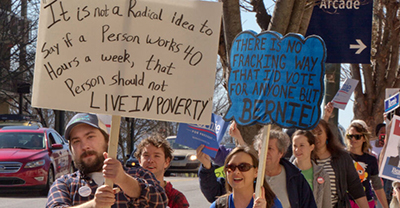By Staff
Poor and low-income people accounted for more than a third of all voters overall in the 2020 presidential election, and their turnout was especially strong in tight battleground states, according to a study that the Poor People’s Campaign: A National Call for Moral Revival released Friday, Oct. 15.
The study, titled “Waking the Sleeping Giant: Low-Income Voters and the 2020 Elections” also shows that of the 168 million people who voted in 2020, 59 million — 35% — were poor or low-income, meaning they have an estimated annual income of less than $50,000. The 2020 presidential elections saw the highest voter turnout in U.S. election history, including among low-income voters.
“This cuts against common misperceptions that poor and low-income people are apathetic about politics or inconsequential to electoral outcomes,” the executive summary of the study reads.
The Poor People’s Campaign: A National Call for Moral Revival (PPC: NCMR) held a news conference at 11 a.m. ET Friday, Oct. 15.
Ahead of the 2020 vote, the PPC: NCMR launched a nonpartisan voter outreach drive across 16 states, targeting urban and rural areas. The action reached over 2.1 million voters, the vast majority of whom were eligible low-income voters.
Low-income voters who were contacted by PPC: NCMR had a higher turnout rate than similarly positioned voters who were not contacted in those same states.
“The drive had a statistically significant impact in drawing eligible low-income voters into the active voting electorate, showing that intentional efforts to engage low-income voters — around an agenda that includes living wages, health care, strong anti-poverty programs, voting rights and policies that fully address injustices of systemic racism, poverty, ecological devastation and the war economy — can be effective across state borders and racial lines,” the report says.
For example, in Georgia, which Joe Biden carried, marking the first presidential victory for a Democrat in that state since 1992, PPC: NCMR’s voter outreach helped bring over 39,000 non-voters from 2016 into the 2020 elections. Those voters accounted for more than three times the final margin of victory in Georgia’s presidential tally.
There’s no proven link that that outreach decided the election, but it does show the potential impact of low-income voters, the study says.
“To turn the opportunity to vote into a reality for low-income voters will require expanded efforts to increase both their registration and turnout on election day, such as automatic voter registration, same day registration, no-excuse mail-in voting, early voting, more polling stations and extended and longer voting hours.” the study says.
Speakers for the news conference include the co-chairs of the PPC: NCMR, Rev. Dr. William J. Barber II and Rev. Dr. Liz Theoharis; Penda Hair, senior counsel for Forward Justice and impacted people.
The study also shows the importance of low-income white voters and of building a fusion coalition of voters of various races and ethnicities.
“While the narrative that white low-income voters are voting not only against their own interests, but also the interests of other racial segments of low-income voters, persisted through the 2020 elections, our analysis suggests something significantly different,” the report says.
“The findings suggest that, rather than writing white low-income voters off, it is possible to build coalitions of low-income voters across race around a political agenda that centers the issues they have in common.”
Key findings of the report on the 2020 elections:
In the 2020 elections, low-income voters exceeded 20% of the total voting population in 45 states and Washington D.C. In tight battleground states, low-income voters accounted for 34% to 45% of the voting population, including in states that flipped party outcomes from 2016 to 2020.
In battleground states where the margin of victory was near or less than 3%, low-income voters accounted for an even greater share of the total votes: Arizona (39.96%), Georgia (37.74%), Michigan (37.81%), Nevada (35.78%), North Carolina (43.67%), Pennsylvania (34.12%), and Wisconsin (39.80%).
A closer look at the racial demographics of low-income voters in nine battleground states shows that white low-income voters accounted for a higher vote share than all other racial groupings of low-income voters combined.
Those states are the seven listed above along with Florida and Texas.
Shailly Gupta Barnes, policy director for the PPC: NCMR, is the author of the study, which was written with analysis and data from TargetSmart.
The study is a follow-up to one that the Poor People’s Campaign released in August 2020 titled “Unleashing the Power of Poor and Low-Income Americans.”
That study showed that if these potential low-income voters voted at a similar voting rate as higher income voters in the 2016 election, then they would match or exceed the presidential election margin of victory in 15 states.

